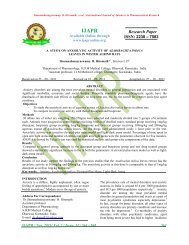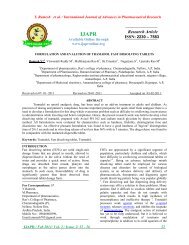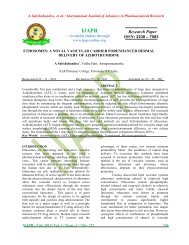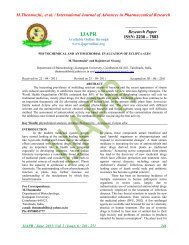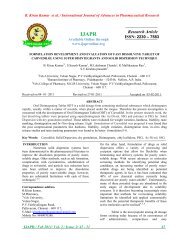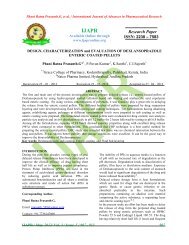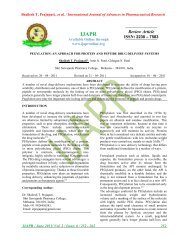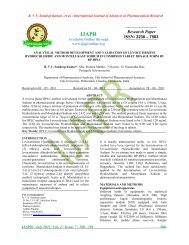formulation and characterizatin of transdermal patches by using ...
formulation and characterizatin of transdermal patches by using ...
formulation and characterizatin of transdermal patches by using ...
You also want an ePaper? Increase the reach of your titles
YUMPU automatically turns print PDFs into web optimized ePapers that Google loves.
Jadhav Yogesh L et al. / International Journal <strong>of</strong> Advances in Pharmaceutical Research<br />
IJAPR<br />
Available Online through<br />
www.ijapronline.org<br />
Review Article<br />
ISSN: 2230 – 7583<br />
AN OVERVIEW: MOUTH DISSOLVING TABLET<br />
Jadhav Yogesh L*., Dr. Parashar Bharat<br />
Department Of Pharmaceutics, Manav Bharti University, Solan. (H.P.)<br />
Received on 20 – 07 - 2012 Revised on 15 – 08- 2012 Accepted on 01– 09 – 2012<br />
ABSTRACT<br />
Swallowing a pill is a major difficulty encountered in case <strong>of</strong> geriatric <strong>and</strong> pediatric patient which leads to poor<br />
patient compliance due to unpalatable taste <strong>of</strong> drug. To troubleshoot these problems a new dosage form known as<br />
mouth-dissolving tablet (MDT), has been developed which rapidly disintegrate <strong>and</strong> dissolve in saliva.MDT are<br />
intended <strong>and</strong> designed to disintegrate <strong>and</strong> dissolve in saliva <strong>and</strong> then easily swallowed without need <strong>of</strong> water which<br />
is a major benefit over conventional dosage form. These dosage forms are also used to attain instant a higher<br />
concentration <strong>of</strong> drug in body for immediate actions. Mouth dissolving tablets can be prepared <strong>by</strong> <strong>using</strong> various<br />
conventional methods like direct Compression, wet granulation, moulding, spray drying, freeze drying, <strong>and</strong><br />
sublimation method <strong>and</strong> <strong>by</strong> <strong>using</strong> different type <strong>of</strong> superdisintegrants like Cross linked carboxymelhylcellulose<br />
(Croscarmelose),Sodium starch glycolate (Primogel, Explotab),Polyvinylpyrrolidone (Polyplasdone) etc. This<br />
review discusses the method <strong>of</strong> preparation, advantages, disadvantage, characterization ,mechanisms; drugs to be<br />
incorporated in the mouth dissolving tablet <strong>and</strong> evaluation <strong>of</strong> the product <strong>and</strong> future trend <strong>of</strong> the mouth dissolving<br />
tablet.<br />
Key Words: Mouth dissolving tablets, Conventional techniques, patented technology.<br />
INTRODUCTION<br />
A mouth dissolving system can be defined as a solid<br />
dosage form for oral administration, which when<br />
placed in mouth, rapidly dispersed or dissolved <strong>and</strong><br />
can be swallowed in the form <strong>of</strong> liquid. Mouth<br />
dissolving tablets are solid tablets <strong>and</strong> designed to<br />
dissolve/disintegrate in the patient’s mouth within<br />
few seconds or minutes, without the need to drink or<br />
chew 1 . The fear <strong>of</strong> taking solid tablets <strong>and</strong> the risk <strong>of</strong><br />
choking for certain patient populations still exist<br />
despite their short disintegration/dissolution times.<br />
However some patients, particularly pediatrics <strong>and</strong><br />
geriatric patients have difficulty swallowing or<br />
chewing solid dosage forms (conventional dosage<br />
forms) to fear <strong>of</strong> choking <strong>and</strong> unwillingness 2 . Mouth<br />
dissolving <strong>and</strong> mouth dispersing drug delivery<br />
system may <strong>of</strong>fer a solution to these problems.<br />
Author Correspondence<br />
Jadhav Yogesh L.<br />
Department Of Pharmaceutics,<br />
Manav Bharti University,<br />
Solan. (H.P.)<br />
Jadhav.yogesh530@gmail.com<br />
08421504215<br />
When the mouth disintegrating tablet is orally<br />
applied, the drug substance has to be dissolved so<br />
that can be absorbed. Dissolution process consists <strong>of</strong><br />
various processes, e.g. wetting, disintegration <strong>and</strong><br />
dissolution. Mouth disintegrating tablets which are<br />
generally contains several excipients are involved in<br />
complex series <strong>of</strong> dissolution process that begin<br />
when the solvent contacts the solid <strong>and</strong> penetrates<br />
the tablet matrix 3 . Effect <strong>of</strong> excipients is assumed to<br />
be related to the surface properties <strong>of</strong> the particles<br />
<strong>and</strong> solid matrix structure 4,5 .<br />
Recently mouth dissolving <strong>formulation</strong><br />
is popular as Novel Drug Delivery Systems because<br />
they are easy to administer <strong>and</strong> lead to better patient<br />
compliance. Pediatric <strong>and</strong> geriatric patient have<br />
difficulty in swallowing the conventional dosage<br />
forms these dosage forms dissolve or disintegrate in<br />
the cavity within a minute without the need <strong>of</strong> water<br />
or chewing. For these <strong>formulation</strong>s, the small<br />
volume <strong>of</strong> saliva is usually sufficient to result in<br />
tablet disintegration in the oral cavity. The<br />
medication can then be absorbed partially or entirely<br />
into the systemic circulation from blood vessels in<br />
the sublingual mucosa, or it can be swallowed as a<br />
IJAPR / Sept. 2012/ Vol. 3 /Issue. 9 / 1100 – 1105 1100
Jadhav Yogesh L et al. / International Journal <strong>of</strong> Advances in Pharmaceutical Research<br />
solution to be absorbed from the gastrointestinal<br />
tract. 6-8<br />
The dispersible tablets allows dissolution<br />
or dispersion in water prior to administration but the<br />
Mouth Dissolving Tablet instead <strong>of</strong> dissolving or<br />
disintegrating in water is expected to dissolve or<br />
disintegrate in oral cavity without drinking water.<br />
The disintegrated mass then slides down smoothly<br />
along the esophagus along with saliva. The growing<br />
importance <strong>of</strong> mouth dissolving tablet was<br />
underlined recently when European Pharmacopoeia<br />
adopted the term “Or dispersible Tablet” as a tablet<br />
that to be placed in the mouth where it disperses<br />
rapidly before swallowing. 9<br />
The main criteria for mouth<br />
disintegrating(dissolving) tablet is to disintegrate or<br />
dissolve rapidly in oral cavity with saliva in 15 to 60<br />
seconds, without need <strong>of</strong> water <strong>and</strong> should have<br />
pleasant mouth feel. Mouth dissolving tablets are<br />
also known as mouth dissolving tablet, melt in<br />
mouth tablet, rapiment, porous tablet, orodispersible<br />
tablet, Rapidly Disintegrating tablet, or mouth<br />
disintegrating tablet.<br />
Benefits <strong>of</strong> Mouth Dissolving Tablets: 10,13,14,15<br />
1. Administered without water, anywhere, any time.<br />
2. Suitability for geriatric <strong>and</strong> pediatric patients, who<br />
experience difficulties in swallowing <strong>and</strong> for<br />
the other groups that may experience problems <strong>using</strong><br />
conventional oral dosage form, due to being<br />
mentally ill, the developmentally disable <strong>and</strong> the<br />
patients who are un-cooperative, or are on reduced<br />
liquid intake plans or are nauseated.<br />
3. Beneficial in cases such as motion sickness, suede<br />
episodes <strong>of</strong> allergic attack or coughing, where an<br />
ultra rapid onset <strong>of</strong> action required.<br />
4. An increased bioavailability, particularly in cases<br />
<strong>of</strong> insoluble <strong>and</strong> hydrophobic drugs, due to rapid<br />
disintegration <strong>and</strong> dissolution <strong>of</strong> these tablets.<br />
5. Stability for longer duration <strong>of</strong> time, since the<br />
drug remains in solid dosage form till it is consumed.<br />
So, it combines advantage <strong>of</strong> solid dosage form in<br />
terms <strong>of</strong> stability <strong>and</strong> liquid dosage form in terms <strong>of</strong><br />
bioavailability.<br />
Limitations <strong>of</strong> Mouth Dissolving Tablets: 10,11<br />
The tablets usually have insufficient mechanical<br />
strength. Hence, careful h<strong>and</strong>ling is required. The<br />
tablets may leave unpleasant taste <strong>and</strong>/or grittiness in<br />
mouth if not formulated properly.<br />
Fundamentals <strong>of</strong> Mouth Dissolving Tablet: 12<br />
For rapid dissolution or disintegration <strong>of</strong> dosage<br />
form, water must rapidly penetrate into the tablet<br />
matrix to cause quick disintegration <strong>and</strong><br />
instantaneous dissolution <strong>of</strong> the tablet. Several<br />
techniques are used to achieve these fundamentals,<br />
to formulate mouth-dissolving tablet. Some <strong>of</strong> the<br />
techniques are described below.<br />
TECHNIQUES FOR PREPARING MOUTH<br />
DISSOLVING TABLETS<br />
Conventional Techniques: 16,20<br />
Disintegrates addition: Disintegrate addition<br />
technique is one popular techniques for formulating<br />
Mouth-dissolving tablets because <strong>of</strong> its easy<br />
implementation <strong>and</strong> cost-effectiveness. The basic<br />
principle involved in formulating Mouth-dissolving<br />
tablets <strong>by</strong> disintegrates addition technique is addition<br />
<strong>of</strong> superdisintegrants in optimum concentration so as<br />
to achieve mouth dissolving along with the good<br />
mouth feel.<br />
Moulding: In this method, molded tablets are<br />
prepared <strong>by</strong> <strong>using</strong> water-soluble ingredients so that<br />
the tablets dissolve completely <strong>and</strong> rapidly. The<br />
powder blend is moistened with a hydro-alcoholic<br />
solvent <strong>and</strong> is molded into tablets under pressure<br />
lower than that used in conventional tablet<br />
compression. The solvent is then removed <strong>by</strong> airdrying.<br />
Molded tablets are very less compact than<br />
compressed tablets. These possess porous structure<br />
that enhances dissolution.<br />
Freeze drying: A process in which water is<br />
sublimated from the product after freezing.<br />
Lyophilization is a pharmaceutical technology which<br />
allows drying <strong>of</strong> heat sensitive drugs <strong>and</strong> biological<br />
at low temperature under conditions that allow<br />
removal <strong>of</strong> water <strong>by</strong> sublimation. Lyophilization<br />
results in preparations, which are highly porous, with<br />
a very high specific surface area, which dissolve<br />
rapidly <strong>and</strong> show improved absorption <strong>and</strong><br />
bioavailability.<br />
Sublimation: The slow dissolution <strong>of</strong> the<br />
compressed tablet containing even highly watersoluble<br />
ingredients is due to the low porosity <strong>of</strong> the<br />
tablets. Inert solid ingredients that volatilize<br />
readily (e.g. urea, ammonium carbonate, ammonium<br />
bicarbonate, camphor etc.) were added to the other<br />
tablet ingredients <strong>and</strong> the mixture is compressed into<br />
tablets. The volatile materials were then removed via<br />
sublimation, which generates porous structures.<br />
Additionally, several solvents (e.g. cyclohexane,<br />
benzene) can be also used as pore forming agents.<br />
Spray-Drying: Spray drying can produce highly<br />
porous <strong>and</strong> fine powders that dissolve rapidly. The<br />
<strong>formulation</strong>s are incorporated <strong>by</strong> hydrolyzed <strong>and</strong> non<br />
hydrolyzed gelatins as supporting agents, mannitol<br />
as bulking agent, sodium starch glycolate or<br />
crosscarmellose sodium as disintegrating <strong>and</strong> an<br />
acidic material (e.g. citric acid) <strong>and</strong> or alkali material<br />
(e.g. I sodium bicarbonate) to enhance disintegration<br />
<strong>and</strong> dissolution. Tablet compressed from the spray<br />
dried powder disintegrated within 20 seconds when<br />
immersed in an aqueous medium.<br />
Mass-Extrusion: This technology involves<br />
s<strong>of</strong>tening the active blend <strong>using</strong> the solvent mixture<br />
IJAPR / Sept. 2012/ Vol. 3 /Issue. 9 / 1100 – 1105 1101
Jadhav Yogesh L et al. / International Journal <strong>of</strong> Advances in Pharmaceutical Research<br />
<strong>of</strong> water soluble polyethylene glycol, <strong>using</strong> methanol<br />
<strong>and</strong> expulsion <strong>of</strong> s<strong>of</strong>tened mass through the extruder<br />
or syringe to get a cylinder <strong>of</strong> the product into even<br />
segments <strong>using</strong> heated blade to form tablets. The<br />
dried cylinder can also be used to coat granules <strong>of</strong><br />
bitter tasting drugs <strong>and</strong> there<strong>by</strong> masking their bitter<br />
taste.<br />
Direct Compression: Direct compression method is<br />
the easiest way to manufacture tablets. Conventional<br />
equipment, commonly available excipients <strong>and</strong> a<br />
limited number <strong>of</strong> processing steps are involved in<br />
direct compression. Also high doses can be<br />
accommodated <strong>and</strong> final weight <strong>of</strong> tablet can easily<br />
exceed that <strong>of</strong> other production methods. Directly<br />
compressed tablet's disintegration <strong>and</strong> solubilization<br />
depends on single or combined action <strong>of</strong><br />
disintegrants, water soluble excipients <strong>and</strong><br />
effervescent agent.<br />
PATENTED TECHNOLOGIES 16<br />
Flashtab Technology: Prographarm laboratories<br />
have patented the Flashtab technology. Tablets<br />
prepared <strong>by</strong> this system consist <strong>of</strong> an active<br />
ingredient in the form <strong>of</strong> micro crystals. Drug micro<br />
granules may be prepared <strong>by</strong> <strong>using</strong> the conventional<br />
techniques like coacervation, micro encapsulation,<br />
<strong>and</strong> extrusion spheronisation. All the processing<br />
utilized conventional tabletting technology.<br />
Wowtab Technology: Wowtab Technology is<br />
patented <strong>by</strong> "Yamanouchi Pharmaceutical Co. "<br />
WOW means "Without Water ". In this process,<br />
combination <strong>of</strong> low mouldability saccharides <strong>and</strong><br />
high mouldability saccharides is used to obtain a<br />
rapidly melting strong tablet. The active ingredient is<br />
mixed with a low mouldability saccharide <strong>and</strong><br />
granulated with a high mouldability saccharide <strong>and</strong><br />
compressed into tablet.<br />
Flash Dose Technology: Flash dose technology has<br />
been patented <strong>by</strong> "Fuisz". Nur<strong>of</strong>en meltlet, a new<br />
form <strong>of</strong> ibupr<strong>of</strong>en as melt-in-mouth tablets, prepared<br />
<strong>using</strong> flash dose technology is the first commercial<br />
product launched <strong>by</strong>" Biovail Corporation". Flash<br />
dose tablets consists <strong>of</strong> self binding shearform matrix<br />
termed as "floss". Shearform matrices are prepared<br />
<strong>by</strong> flash heat processing.<br />
Orasolv Technology: Orasolv Technology has been<br />
developed <strong>by</strong> "CIMA" labs. In this system active<br />
medicament is taste masked. It also contains<br />
effervescent disintegrating agent. Tablets are made<br />
<strong>by</strong> direct compression technique at low compression<br />
force in order to minimize oral dissolution time.<br />
Conventional blenders <strong>and</strong> tablet machine is used to<br />
produce the tablets. The tablets produced are s<strong>of</strong>t <strong>and</strong><br />
friable <strong>and</strong> packaged in specially designed pick <strong>and</strong><br />
place system. Durasolv Technology: Durasolv is the<br />
patented technology <strong>of</strong> "CIMA" labs. The tablets<br />
made <strong>by</strong> this technology consist <strong>of</strong> a drug, fillers <strong>and</strong><br />
a lubricant. Tablets are prepared <strong>by</strong> <strong>using</strong><br />
conventional tableting equipment <strong>and</strong> have good<br />
rigidity. These can be packed into conventional<br />
packaging system like blisters. Durasolv is an<br />
appropriate technology for products requiring low<br />
amounts <strong>of</strong> active ingredients.<br />
Zydis Technology: This technology involves<br />
s<strong>of</strong>tening the active blend <strong>using</strong> the solvent mixture<br />
<strong>of</strong> water soluble polyethylene glycol, <strong>using</strong> methanol<br />
<strong>and</strong> expulsion <strong>of</strong> s<strong>of</strong>tened mass through the extruder<br />
or syringe to get a cylinder <strong>of</strong> the product into even<br />
segments <strong>using</strong> heated blade to form tablets. The<br />
dried cylinder can also be used to coat granules <strong>of</strong><br />
bitter tasting drugs <strong>and</strong> there<strong>by</strong> masking their bitter<br />
taste.<br />
CRITERIA FOR DRUG SELECTION 18<br />
The ideal characteristics <strong>of</strong> a drug for in vivo<br />
dissolution from an MDT include<br />
1. No bitter taste.<br />
2. Dose lower than 20mg.<br />
3. Small to moderate molecular weight.<br />
4. Good stability in water <strong>and</strong> saliva.<br />
5. Partially non-ionized at the oral cavities<br />
pH<br />
6. Ability to diffuse <strong>and</strong> partition into the<br />
epithelium <strong>of</strong> the upper GIT<br />
7. Ability to permeate oral mucosal tissue.<br />
8. Unsuitable drug characteristic for MDT<br />
9. Short half-life <strong>and</strong> frequent dosing.<br />
10. Very bitter or otherwise unacceptable<br />
taste because taste masking cannot be<br />
achieved.<br />
11. Required controlled or sustained<br />
release.<br />
DRUGS USED IN MOUTH DISSOLVING<br />
DRUG DELIVERY SYSTEM 21-23<br />
1. Analgesic <strong>and</strong> anti-inflammarory Agents-<br />
Ibupr<strong>of</strong>en, Proxicam, Mefenamic Acid<br />
2. Anti-bacterial Agent-Erythromycin,<br />
Tetracycline, Doxycycline, Rifampcin<br />
3. Anti-fungal Agents-Grise<strong>of</strong>ulvin, Miconazole<br />
4. Anti-Malarials-Chlorquine, Amodiaquine<br />
5. Anti-Gout Agent- Allopurinol, Probenecid<br />
6. Anti-Hypertensive -Amlodipine, Nefidipine<br />
7. Anti-Coagulants-Glipizide, Tolbutamide<br />
8. Anti-Protozoal Agents- Benznidazole, Tinidazole<br />
9. Anti-Thyroid agent-Carbimazole<br />
10. Cardiac Inotropic Agent-Digitoxin,Digoxis<br />
11. Gastro-Intestinal Agents- Omeprazole,<br />
Ranitidine, Fomatidine<br />
12. Nutritional Agents-Vitamin A, Viitamin B,<br />
Vitamin D, etc.<br />
IJAPR / Sept. 2012/ Vol. 3 /Issue. 9 / 1100 – 1105 1102
Jadhav Yogesh L et al. / International Journal <strong>of</strong> Advances in Pharmaceutical Research<br />
13. Oral Vaccine-Influenza, Hepatitis, Polio,<br />
Tuberculosis,etcs<br />
SUPER DISINTEGRANTS USED IN MDTS 17-19<br />
As day’s passes, dem<strong>and</strong> for mouther<br />
disintegrating <strong>formulation</strong> is increased. So,<br />
pharmacist needs to formulate disintegrants i.e.<br />
Superdisintegrants which are effective at low<br />
concentration <strong>and</strong> have greater disintegrating<br />
efficiency <strong>and</strong> they are more effective<br />
intragranularly.<br />
Various types <strong>of</strong> super disintegrants used are as<br />
follows:<br />
1. Crosspovidone<br />
2. Microcrystalline cellulose<br />
3. Sodium starch glycollate<br />
4. Sodium carboxy methyl cellulose or cross<br />
carmelose sodium<br />
5. Pregelatinzed starch<br />
6. Calcium carboxy methyl cellulose<br />
7. Modified corn starch.<br />
8. Sodium starch glycollate<br />
9. crosscarmellose sodium.<br />
Factors to be considered for selection <strong>of</strong><br />
superdisintegrants<br />
1. It should produce mouth dissolving when<br />
tablet meets saliva in the mouth<br />
2. It should be compactable enough to produce<br />
less-friable tablets.<br />
3. It can able to produce good mouth feel to<br />
the patient. Thus, small particle size is<br />
preferred to achieve patient compliance.<br />
4. It should has good flow since it improve the<br />
flowability <strong>of</strong> the total blend.<br />
EVALUATION OF TABLETS 24-26<br />
General Appearance: The general appearances <strong>of</strong> a<br />
tablet include size, shape, colour, taste, odour,<br />
surface texture.<br />
Size, Shape, Thickness And Diameter: The size<br />
<strong>and</strong> shape <strong>of</strong> the tablet can be dimensionally<br />
described, monitored <strong>and</strong> controlled. Thickness <strong>of</strong><br />
tablets is an important characteristic for appearance<br />
<strong>and</strong> also in counting <strong>by</strong> <strong>using</strong> filling equipment.<br />
Some filling equipment utilizes the uniform<br />
thickness <strong>of</strong> the tablets as a counting mechanism.<br />
Ten tablets were taken <strong>and</strong> their thickness measured<br />
<strong>by</strong> vernier caliper.<br />
Measurement Of Tablet Tensile Strength The<br />
tablet tensile strength is the force required to break a<br />
tablet <strong>by</strong> compressing it in the radial direction <strong>and</strong> is<br />
measured <strong>using</strong> a tablet hardness tester. For<br />
measuring the hardness <strong>of</strong> the tablets, the plunger <strong>of</strong><br />
the hardness tester is driven down at a speed <strong>of</strong> 20<br />
mm/min. Tensile strength for crushing (T) is<br />
calculated <strong>using</strong> equation I<br />
Eq. I. T= 2F / πdt<br />
Where, F is the crushing load, <strong>and</strong> d <strong>and</strong> t denote the<br />
diameter <strong>and</strong> thickness <strong>of</strong> the tablet, respectively. 27<br />
Measurement Of Tablet Porosity The mercury<br />
penetration porosimeter can be used to measure the<br />
tablet porosity which is a relative assessment <strong>of</strong> the<br />
degree <strong>of</strong> water penetration in the <strong>formulation</strong>,<br />
responsible for its mouth disintegration. This<br />
instrument is based on the capillary rise phenomenon<br />
where in an excess pressure is required to cause a<br />
non-wetting liquid to climb up a narrow capillary.<br />
The pressure difference across the interface is given<br />
<strong>by</strong> the Washburn equation II, where the pressure<br />
drop is inversely related to the pore size<br />
(perpendicular radius) 28<br />
Eq. II. ΔP = −(2γ/r) cos θ<br />
Where, γ is the surface tension <strong>of</strong> the liquid, r is the<br />
perpendicular radius <strong>and</strong> θ is the angle <strong>of</strong> contact<br />
between the liquid <strong>and</strong> the capillary walls. Pore<br />
radius is calculated from eq II <strong>using</strong> experimental<br />
data obtained in the form <strong>of</strong> P. In this test, the<br />
contact angle between mercury <strong>and</strong> the tablet is kept<br />
at 140° <strong>and</strong> the surface tension at the interface <strong>of</strong><br />
mercury <strong>and</strong> the tablet is 0.486 N/m. Pore sizes in<br />
the range <strong>of</strong> 0.06–360 μm, can be efficiently<br />
measured <strong>by</strong> this technique. 29,30 Otherwise, the tablet<br />
porosity (ε) can also be calculated <strong>using</strong> equation III:<br />
Eq. III. ε = 1-m / (ρtV)<br />
Where, ρt is the true density, <strong>and</strong> m <strong>and</strong> V are the<br />
weight <strong>and</strong> volume <strong>of</strong> the tablet, respectively.<br />
Tablets prepared <strong>by</strong> spray drying, lyophilization <strong>and</strong><br />
cotton c<strong>and</strong>y process generally possess high porosity<br />
<strong>and</strong> therefore, have extremely low disintegration<br />
time.<br />
Wetting Time <strong>and</strong> Water Absorption Ratio A<br />
study on wetting time <strong>and</strong> water absorption ratio<br />
reported the use <strong>of</strong> a piece <strong>of</strong> double folded tissue<br />
paper placed in a petridish containing 6 ml <strong>of</strong> water.<br />
One tablet was placed on this paper <strong>and</strong> the time for<br />
complete wetting <strong>of</strong> tablet was noted as wetting time.<br />
The wetted tablet was then weighed <strong>and</strong> the water<br />
absorption ratio, R, was determined according to<br />
equation IV<br />
Eq. IV. R = 100 (Wa−Wb)/Wb<br />
Where, Wb <strong>and</strong> Wa are the weights <strong>of</strong> tablet before<br />
<strong>and</strong> after water absorption, respectively.<br />
Fineness <strong>of</strong> Dispersion This is a qualitative test<br />
specified <strong>by</strong> EP for dispersible tablets. 31 We<br />
recommend performing this test on tablets which are<br />
not truly mouth dissolving, but are mouth oral<br />
disintegrating tablets (ODTs). It is an assessment <strong>of</strong><br />
the grittiness which arises due to disintegration <strong>of</strong><br />
the tablet into coarse particles. The test is performed<br />
<strong>by</strong> placing two tablets in 100 ml water <strong>and</strong> stirring it<br />
gently, till the tablets get completely disintegrated.<br />
The <strong>formulation</strong> is considered to form a smooth<br />
dispersion if the complete dispersion passes through<br />
IJAPR / Sept. 2012/ Vol. 3 /Issue. 9 / 1100 – 1105 1103
Jadhav Yogesh L et al. / International Journal <strong>of</strong> Advances in Pharmaceutical Research<br />
a sieve screen with a nominal mesh aperture <strong>of</strong> 710<br />
μm without leaving any residue on the mesh.<br />
Uniformity <strong>of</strong> weight: In Indian Pharmacopoeia<br />
procedure for uniformity <strong>of</strong> weight was followed, ten<br />
or twenty tablets were taken <strong>and</strong> their weight was<br />
determined individually <strong>and</strong> collectively on a digital<br />
weighing balance. The average weight <strong>of</strong> one tablet<br />
was determined from the collective weight. The<br />
weight variation test would be a satisfactory method<br />
<strong>of</strong> determining the drug content uniformity.<br />
Hardness <strong>of</strong> Tablets: Hardness <strong>of</strong> tablet is defined<br />
as the force applied across the diameter <strong>of</strong> the tablet<br />
in the order to break the tablet. The resistance <strong>of</strong> the<br />
tablet to chipping, abrasion or breakage under<br />
condition <strong>of</strong> storage transformation <strong>and</strong> h<strong>and</strong>ling<br />
before usage depends on its hardness. Hardness <strong>of</strong><br />
the tablet <strong>of</strong> each <strong>formulation</strong> was determined <strong>using</strong><br />
Monsanto Hardness tester.<br />
Friability <strong>of</strong> tablets: Friabrater consist <strong>of</strong> a plasticchamber<br />
that revolves at 25 rpm, dropping those<br />
tablets at a distance <strong>of</strong> 6 inches with each revolution.<br />
The tablets were rotated in the friabrater for at least 4<br />
minutes. At the end <strong>of</strong> test tablets were removed <strong>and</strong><br />
reweighed, the loss in the weight <strong>of</strong> tablet is the<br />
measure <strong>of</strong> friability <strong>and</strong> is expressed in percentage<br />
as,<br />
%Friability = intial weight - Final weight/intial<br />
weight x 100<br />
Wetting Time: In this method measure tablet<br />
wetting time. Simple tissue paper (12 cm X 10.75<br />
cm) folded twice was placed in a small petridish (ID<br />
= 6.5 cm) containing 6 ml <strong>of</strong> Sorenson’s buffer pH<br />
6.8. A tablet was put on the paper, <strong>and</strong> the time for<br />
complete wetting was measured. Three trials for<br />
each batch <strong>and</strong> the st<strong>and</strong>ard deviation were also<br />
determined.<br />
Solution Volume: In this test take one tablet in a<br />
Petri –dish with suitable solvent. One or two drop <strong>of</strong><br />
solvent used until the tablet shows soluble property<br />
that is called soluble or solution volume. V = Final<br />
volume <strong>of</strong> blend in cm3<br />
In Vitro Disintegration Test: In Vitro disintegration<br />
time was measured <strong>by</strong> dropping a tablet in a beaker<br />
containing 50 ml <strong>of</strong> Sorenson’s buffer pH 6.8. Three<br />
tablets from each <strong>formulation</strong> were r<strong>and</strong>omly<br />
selected <strong>and</strong> In Vitro dispersion time was performed.<br />
32,33<br />
In Vivo Disintegration Test: The test was carried<br />
out on 2 or 3 tablets <strong>using</strong> in the mouth <strong>and</strong> the time<br />
in second taken for complete disintegration <strong>of</strong> the<br />
tablet was measured in few seconds. 34<br />
In Vitro Dissolution Test: In-vitro dissolution study<br />
was performed <strong>by</strong> <strong>using</strong> USP Type II Apparatus<br />
(Paddle type) [Electro lab (ETC-11L) Tablet<br />
Dissolution Tester] at 50 rpm. Phosphate buffer pH<br />
6.8, 900 ml was used as dissolution medium which<br />
maintained at 37±0.5°C. Aliquot <strong>of</strong> dissolution<br />
medium (10 ml) was withdrawn at specific time<br />
intervals (2 min) <strong>and</strong> was filtered. The amount <strong>of</strong><br />
drug dissolved was determined <strong>by</strong> UV<br />
spectrophotometer (Shimadzu, Japan) <strong>by</strong> measuring<br />
the absorbance <strong>of</strong> the sample at 248.0 nm. Three<br />
trials for each batch were performed <strong>and</strong> average<br />
percentage drug release with st<strong>and</strong>ard deviation was<br />
calculated <strong>and</strong> recorded. 32-35<br />
Stability Study (Temperature Dependent): The<br />
mouth dissolving tablets are packed in suitable<br />
packaging <strong>and</strong> stored under the following conditions<br />
for a period as prescribed <strong>by</strong> ICH guidelines for<br />
accelerated studies.<br />
(i) 40 ± 1 °C<br />
(ii) 50 ± 1°c<br />
(iii) 37 ±1 ° C <strong>and</strong> RH 75% ± 5%<br />
The tablets were withdrawn after a period <strong>of</strong> 15 days<br />
<strong>and</strong> analyzed for physical characterization (Visual<br />
defects, Hardness, Friability, Disintegrations, <strong>and</strong><br />
Dissolution etc.) <strong>and</strong> drug content. The data obtained<br />
is fitted into first order equations to determine the<br />
kinetics <strong>of</strong> degradation. Accelerated stability data are<br />
plotting according Arrhenius equation to determine<br />
the shelf life at 25°C. 32-35<br />
Packaging: Packaging special care is required<br />
during manufacturing <strong>and</strong> storage to protect the<br />
dosage <strong>of</strong> other mouth-dissolving dosage forms.<br />
Quick-dispersing <strong>and</strong>/or dissolving oral delivery<br />
systems, the system can be packaged <strong>using</strong> various<br />
options, such as single pouch, blister card with<br />
multiple units, multiple unit dispenser, <strong>and</strong><br />
continuous roll dispenser, depending on the<br />
application <strong>and</strong> marketing objectives. 35<br />
FUTURE TRENDS<br />
These dosage forms may be suitable for the oral<br />
delivery <strong>of</strong> drugs such as protein <strong>and</strong> peptide-based<br />
therapeutics that have limited bioavailability when<br />
administered <strong>by</strong> conventional tablets. These products<br />
usually degrade rapidly in the stomach. Should next<br />
generation drugs be predominantly protein or peptide<br />
based, tablets may no longer be the dominant format<br />
for dosing such moieties. Injections generally are not<br />
favored for use <strong>by</strong> patients unless facilitated <strong>by</strong><br />
sophisticated auto-injectors. Inhalation is one good<br />
alternative system to deliver these drugs, but the<br />
increased research into biopharmaceuticals so far has<br />
generated predominantly chemical entities with low<br />
molecular weights. The developments <strong>of</strong> enhanced<br />
oral protein delivery technology <strong>by</strong> ODTs which<br />
may release these drugs in the oral cavity are very<br />
promising for the delivery <strong>of</strong> high molecular weight<br />
protein <strong>and</strong> peptide.<br />
IJAPR / Sept. 2012/ Vol. 3 /Issue. 9 / 1100 – 1105 1104
Jadhav Yogesh L et al. / International Journal <strong>of</strong> Advances in Pharmaceutical Research<br />
REFERENCES<br />
1) Seager H, Drug delivery products <strong>and</strong> the Zydus mouthdissolving<br />
dosage form, J Pharm Pharmacol,1998, 50, 375 – 82.<br />
2) Kaushik D.,Dureja S <strong>and</strong> Saini T.R., Mouth dissolving tablets –<br />
A Review, Indian Drugs 2003, 41(4), 187 – 193.<br />
3) Indurwade N.H, Rajyaguru T.H, <strong>and</strong> Nakhat P.D, Novel<br />
approach in mouth dissolving tablets,Indian drugs, 39(8) Aug,<br />
405 – 409.<br />
4) Hiremath J.G, Shastry C.S <strong>and</strong> Srinath M.S, pharmaceutical<br />
approaches <strong>of</strong> taste masking in oral dosage form, Indian drugs<br />
41(5) May 2004,253 – 257.<br />
5) Fukami J et al, evaluation <strong>of</strong> rapidly disintegrating tablets<br />
containing glycine <strong>and</strong> carboxymethylcellulose. Int J Pharm.<br />
2006; 310:101 – 109.<br />
6) Berner, B., R. Birudaraj, S. Shen <strong>and</strong> X. Li, 2005.Buccal<br />
permeation <strong>of</strong> buspirone: mechanistic studies on transport<br />
pathways. J. Pharm. Sci, 94: 70-78.<br />
7) Ishikawa, T., N. Koizumi <strong>and</strong> B. Mukai,<br />
2001.Pharmacokinetics <strong>of</strong> acetaminophen from rapidly<br />
disintegrating compressed tablet prepared <strong>using</strong> microcrystalline<br />
cellulose (PH-M-06) <strong>and</strong> spherical sugar granules. Chem Pharm<br />
Bull (Tokyo),49: 230-232.<br />
8) Price, T.M., K.L. Blauer, M. Hansen <strong>and</strong> F. Stanczyk, 1997.<br />
Single-dose pharmacokinetics <strong>of</strong> sublingual versus oral<br />
administration <strong>of</strong> micronized 17 beta-estradiol. Obstet Gynecol,<br />
89: 340-345.<br />
9) Howard C. Ansell, Nicholas G. Popvich,Loyd V. Allen, Jr.<br />
“Pharmaceutical Dosage Forms <strong>and</strong> Drug Delivery System”<br />
First Edition; PP 78 (1995)<br />
10) Jain N.K.<strong>and</strong> Sharma S.N.; “A Text book <strong>of</strong> Pr<strong>of</strong>essional<br />
Pharmacy” Fourth Edition, 6,(1998)<br />
11) Mehta R.M. “Pharmaceutics I” Third Edition; PP 7,238 (2002)<br />
12) Lachman, L. <strong>and</strong> Liebermann, H.A“Theory <strong>and</strong> Practice <strong>of</strong><br />
Industrial Pharmacy” Third<br />
Edition, PP 293-294, (1990)<br />
13) Lachman, L. <strong>and</strong> Liebermann,H.A.“Theory <strong>and</strong> Practice <strong>of</strong><br />
Industrial Pharmacy” Third Edition, PP 329-335,(1990)<br />
14) Liebermann, H.A. “Pharmaceutical Dosage Forms; Tablets”<br />
Second Edition,Volume-I, PP 136<br />
15) Liebermann, H.A.“Pharmaceutical Dosage Forms;<br />
Tablets”Second Edition, Volume-I, PP 198-199<br />
16) Sharma S., (2008)., New generation <strong>of</strong> tablet: Mouth<br />
dissolving tablet; Latest review Vol VI.<br />
17) Kumari S., Visht S., Sharma P.K., Yadav R.K., (2010).,<br />
Mouth dissolving Drug delivery system : Review Article; Journal<br />
<strong>of</strong> Pharmacy Research 3(6).,1444-1449.<br />
18) C. Kumaresan., (2008)., Orally Disintegrating Tablet - Mouth<br />
dissolving, Sweet Taste, And Target Release Pr<strong>of</strong>ile;<br />
Pharmaceutical review Vol-6.<br />
19) Solanki A.B., Parikh J.R., Parikh R.H., (2007)., Formulation<br />
<strong>and</strong> Optimization <strong>of</strong> Piroxicam Proniosomes <strong>by</strong> 3-Factor, 3-Level<br />
Box-Behnken Design; AAPS PharmSciTech. 8(4).<br />
20) Chaudhari P.D., Chaudhari S.P., Lanke S.D. <strong>and</strong> Patel N.,(<br />
2007)., Formulation <strong>and</strong> in vitro evaluation <strong>of</strong> teste masked<br />
orodispersible dosage form <strong>of</strong> Levocetirizine dihydrochloride;<br />
Indian journal <strong>of</strong> pharmacuitical Education <strong>and</strong> research<br />
41(4).,319-327.<br />
21) Fransesco, C., Mouth Dissolving mucoadhesive<br />
microparticulate delivery system containing Piroxicam, Eur. J.<br />
pharm. Sci. 2005, 24: 355-361.<br />
22) Abdelbary, G., Determination <strong>of</strong> the in-vitro disintegration<br />
pr<strong>of</strong>ile <strong>of</strong> rapidly disintegrating tablets <strong>and</strong> correlation with oral<br />
disintegration, Int. J. Pharm., 2005,292(12): 29-41.<br />
23) Rasetti-Esacarguelli, C., Grange, V., Pharmacokinetic pr<strong>of</strong>ile<br />
<strong>of</strong> two tablet <strong>formulation</strong>s <strong>of</strong> Piroxicam, Int. J. Pharm., 2005, 13:<br />
129-134.<br />
24) Lalla. J K., Mamania, H. M., Mouth dissolving r<strong>of</strong>ecoxib<br />
tablets, Indian J. Pharm. Sci., 2004, 59(4), 23-26.<br />
25) Kuchekar, B. S., Mahajan, S., <strong>and</strong> B<strong>and</strong>han, A. C., Mouth<br />
dissolve tablets <strong>of</strong> sumatriptan, Indian Drugs, 2004,41(10), 592-<br />
598.<br />
26) Lorenzp- Lamosa, M.L., Cuna, M., Vila-Jato, J.L. <strong>and</strong> Torres,<br />
D., J. Microencapsul.,1997, 14, 607.<br />
27) Bi YX, Sunada H, Yonezawa Y, Danjo K.Evaluation <strong>of</strong><br />
rapidly disintegrating tablets prepared <strong>by</strong> a direct compression<br />
method. Drug Dev Ind Pharm. 1999; 25: 571-<br />
581.doi:10.1081/DDC-100102211<br />
28) Allen T.In: Particle size measurement, 5th ed.London:<br />
Chapman<strong>and</strong> Hall,1997:149–187.<br />
29) Alvarez-Lorenzo C, Go´mez-Amoza JL, Martı´nez-Pacheco<br />
R, Souto C, Concheiro A.Evaluation <strong>of</strong> low-substituted<br />
hydroxypropylcelluloses (L-HPCs) as filler-binders for direct<br />
compression Int J Pharm. 2000; 197:107–116 doi:10.1016/S0378-<br />
5173(99)00456-1<br />
30) Sunada H, Bi Y.Preparation, evaluation <strong>and</strong> optimization <strong>of</strong><br />
rapidly disintegrating tablets. Powder Technology. 2002; 122:<br />
188–198.doi:10.1016/S0032-5910(01)00415-6<br />
31) Tablets.European Pharmacopoeia.Ed. 4, Supplement 4.2;<br />
2002. p2435.<br />
32) Shirai, Y., Sogo, K., Yamamoto, K., Kojima, K., Fujioka, H.,<br />
Makita, H. <strong>and</strong> Nakamura,Y., Biol. Pharm. Bull, 1993, 16, 172.<br />
33) Shirai, Y., Sogo, K., Fujioka, H. <strong>and</strong> Nakamura, Y., Biol.<br />
Pharm. Bull., 17, 1994, 427.Pr<strong>of</strong>ile Resources at Business. Com.<br />
Cima Labs - Pr<strong>of</strong>ile. 27 May 2001.<br />
34) Makino, T., Yamada, M. <strong>and</strong> Kikuta, J., Mouth dissolving<br />
tablet <strong>and</strong> its production,1993, EuropeanPatent,<br />
http://www.business.com/directory/ pharmaceuticals <strong>and</strong><br />
biotechnology /drug.<br />
35)Cirri, M., Valleri, M., Mura, P., Maestrelli, F., Ballerini, R.,<br />
Development <strong>of</strong> mouth dissolving tablets <strong>of</strong> flurbipr<strong>of</strong>encyclodextrin<br />
complexes, Drug Dev. Ind. Pharm., 2005, 31(7), 697-<br />
707.<br />
INTERNATIONAL CONGRESS IN PHARMACY AND HEALTH SCIENCES<br />
Pharma Science Tech Association, Foundation No: AP/PSTA/56/2012.<br />
Please visit for Details: www.icphsmembership.com<br />
Totally three types<br />
FICPHS (Fellowship in International Congress in Pharmacy <strong>and</strong> Health Sciences), MICPHS (Member in International Congress in<br />
Pharmacy <strong>and</strong> Health Sciences), AMICPHS (Associate Member in International Congress in Pharmacy And Health Sciences)<br />
Eligibility<br />
FICPHS: Ph.D in Chemistry/ Pharmacy / M.Sc / M.Pharm with 2 years experience, MICPHS: M.Sc / M.Pharm (or) B.Sc / B.Pharm with<br />
2 years experience, AMICPHS: B.Sc (or) B.Pharmacy<br />
IJAPR / Sept. 2012/ Vol. 3 /Issue. 9 / 1100 – 1105 1105



